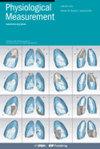Measuring blood pressure from Korotkoff sounds as the brachial cuff inflates on average provides higher values than when the cuff deflates.
IF 2.3
4区 医学
Q3 BIOPHYSICS
引用次数: 0
Abstract
OBJECTIVES In this study, we test the hypothesis that if, as demonstrated in a previous study, brachial arteries exhibit hysteresis as the occluding cuff is deflated and fail to open until cuff pressure (CP) is well below true intra-arterial blood pressure (IAPB), estimating systolic (SBP) and diastolic blood pressure (DBP) from the presence of Korotkoff sounds as CP increases may eliminate these errors and give more accurate estimates of SBP and DBP relative to IABP readings. Approach. In 62 subjects of varying ages (45.1±19.8, range 20-6 - 75.8 years), including 44 men (45.3±19.4, range 20.6 - 75.8 years) and 18 women (44.4±21.4, range 20.9 - 75.3 years), we sequentially recorded SBP and DBP both during cuff inflation and cuff deflation using Korotkoff sounds. Results. There was a significant (p<0.0001) increase in SBP from 122.8±13.2 to 127.6±13.0 mmHg and a significant (p=0.0001) increase in DBP from 70.0±9.0 to 77.5±9.7 mmHg. Of the 62 subjects, 51 showed a positive increase in SBP (0 to 14 mmHg) and 11 subjects showed a reduction (-0.3 to -7 mmHg). The average differences for SBP and DBP estimates derived as the cuff inflates and those derived as the cuff deflates were 4.8±4.6 mmHg and 2.5±4.6mmHg, not dissimilar to the differences reported between IABP and NIBP measurements. Although we could not develop multiparameter linear or non-linear models to explain this phenomenon we have clearly demonstrated through ANOVA tests that both body mass index (BMI) and pulse wave velocity (PWV) are implicated, supporting the hypothesis that the phenomenon is associated with age, higher BMI and stiffer arteries. Significance. The implications of this study are that brachial sphygmomanometry carried out during cuff inflation could be more accurate than measurements carried out as the cuff deflates. Further research is required to validate these results with intra-arterial blood pressure measurements. .根据肱动脉袖带充气时的 Korotkoff 音测量血压,平均比袖带放气时的血压值要高。
目的 在本研究中,我们对以下假设进行了验证:如果如之前的研究所示,肱动脉在闭塞袖带放气时表现出滞后性,直到袖带压力 (CP) 远远低于真实动脉内血压 (IAPB) 时才会打开,那么根据 CP 增加时出现的 Korotkoff 声估计收缩压 (SBP) 和舒张压 (DBP) 可能会消除这些误差,并给出相对于 IABP 读数更准确的 SBP 和 DBP 估计值。方法。我们对 62 名不同年龄的受试者(45.1±19.8,年龄范围 20-6 - 75.8 岁),包括 44 名男性(45.3±19.4,年龄范围 20.6 - 75.8 岁)和 18 名女性(44.4±21.4,年龄范围 20.9 - 75.3 岁),在袖带充气和袖带放气时使用 Korotkoff 声连续记录 SBP 和 DBP。结果显示SBP 从 122.8±13.2 mmHg 显著升高至 127.6±13.0 mmHg,DBP 从 70.0±9.0 mmHg 显著升高至 77.5±9.7 mmHg(p=0.0001)。在 62 名受试者中,51 名受试者的 SBP 呈正增长(0 至 14 mmHg),11 名受试者的 SBP 呈下降(-0.3 至-7 mmHg)。袖带充气时得出的 SBP 和 DBP 估计值与袖带放气时得出的估计值的平均差异为 4.8±4.6 mmHg 和 2.5±4.6mmHg,与 IABP 和 NIBP 测量值之间的差异无异。虽然我们无法建立多参数线性或非线性模型来解释这一现象,但我们通过方差分析测试清楚地表明,体重指数(BMI)和脉搏波速度(PWV)都与此现象有关,从而支持了这一假设,即这一现象与年龄、较高的体重指数和较硬的动脉有关。意义重大。本研究的意义在于,袖带充气时进行的肱动脉血压测量可能比袖带放气时进行的测量更准确。还需要进一步研究,通过动脉内血压测量来验证这些结果。.
本文章由计算机程序翻译,如有差异,请以英文原文为准。
求助全文
约1分钟内获得全文
求助全文
来源期刊

Physiological measurement
生物-工程:生物医学
CiteScore
5.50
自引率
9.40%
发文量
124
审稿时长
3 months
期刊介绍:
Physiological Measurement publishes papers about the quantitative assessment and visualization of physiological function in clinical research and practice, with an emphasis on the development of new methods of measurement and their validation.
Papers are published on topics including:
applied physiology in illness and health
electrical bioimpedance, optical and acoustic measurement techniques
advanced methods of time series and other data analysis
biomedical and clinical engineering
in-patient and ambulatory monitoring
point-of-care technologies
novel clinical measurements of cardiovascular, neurological, and musculoskeletal systems.
measurements in molecular, cellular and organ physiology and electrophysiology
physiological modeling and simulation
novel biomedical sensors, instruments, devices and systems
measurement standards and guidelines.
文献相关原料
| 公司名称 | 产品信息 | 采购帮参考价格 |
|---|
 求助内容:
求助内容: 应助结果提醒方式:
应助结果提醒方式:


